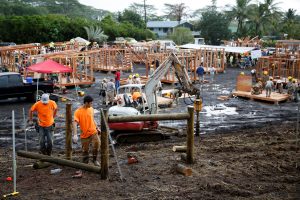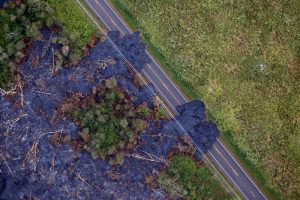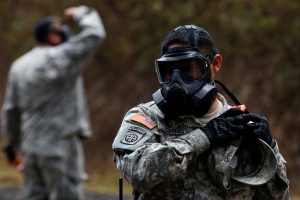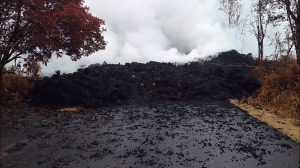
y Jolyn Rosa
HONOLULU (Reuters) – Hurricane Lane, threatening a direct hit as Hawaii’s worst storm in a quarter century, on Thursday churned toward Oahu, the island with the largest population, as schools, government offices, and business closed and residents stocked up on supplies.
Packing sustained winds of up to 130 miles per hour (215 km per hour), Lane could dump 10 to 20 inches (25-50 cm) of rain, triggering flash floods and landslides, the National Weather Service (NWS) said. More than 30 inches could fall in some places, it said.
“Preparations to protect life and property should be rushed to completion,” the NWS Central Pacific Hurricane Center in Honolulu said in an advisory.
As of early Thursday, Lane was centered about 210 miles (335 km) south-southwest of Kailua-Kona, a town on the west coast of the Big Island, the NWS said. It was classified as a powerful Category 4 storm on the five-step Saffir-Simpson scale of hurricane strength.
The NWS said the storm weakened slightly overnight but excessive rainfall would affect the Hawaiian islands into the weekend, “leading to significant and life-threatening flash flooding and landslides.”
More than a foot of rain has already fallen on part of the Big Island, the NWS said on Thursday morning.
The center also warned of “very large and damaging surf” along exposed west- and south-facing shorelines, likely leading to significant coastal erosion.
A hurricane warning was in effect for Oahu, Maui County, and Hawaii County. The islands of Kauai and Niihau remained on hurricane watch and could face similar conditions starting Friday morning.
Governor David Ige has urged residents to take the threat seriously and prepare for the worst by setting aside a 14-day supply of water, food, and medicines.
All public schools, University of Hawaii campuses and nonessential government offices on the islands of Oahu and Kauai will be closed for at least two days starting on Thursday, Ige said Wednesday.
The shelves of a downtown Honolulu Walmart were stripped of items ranging from canned tuna to dog food as well as bottled water and coolers full of ice after warnings of possible power outages.
“I went to Safeway last night for regular groceries. Everyone was in a panic,” said Thao Nguyen, 35, an employee at a Honolulu branch of Hawaiian shirt retailer Roberta Oaks.
Long lines of cars formed at gasoline stations in Honolulu and people pulled small boats from the water ahead of the expected storm surge. U.S. Navy ships and submarines based in Hawaii were instructed to leave port, a common practice when a hurricane approaches to avoid damage.
President Donald Trump declared a state of emergency for Hawaii and ordered federal authorities to help supplement state and local responses, the White House said on Thursday.
The most powerful hurricane on record to hit Hawaii was Category 4 Iniki, which made landfall on Kauai island on Sept. 11, 1992, according to the National Oceanic and Atmospheric Administration. It killed six people and damaged or destroyed more than 14,000 homes.
(Additional reporting by Gina Cherelus in New York, Brendan O’Brien in Milwaukee, Doina Chiacu in Washington, and Steve Gorman and Dan Whitcomb in Los Angeles; Editing by Jeffrey Benkoe and Marguerita Choy)












